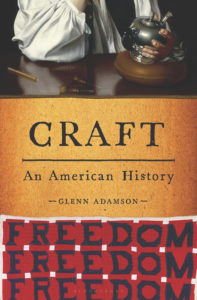Perhaps you are turned off by standard American histories, from expensive textbooks to doorstop-sized biographies of Important Men. You might find descriptions of the conflict between Thomas Jefferson and Alexander Hamilton dry. Or you might not wish to wade through summaries of intellectual debates about education among Blacks during Reconstruction. But set either in a different context — that of craft — and such cornerstones of American history may become meaningful and even exciting to you.

“Craft,” Glenn Adamson explains in his delightful overview of the history of the United States, is anything “a skilled person makes … using their hands.” Published by Bloomsbury in January, Craft: An American History includes stories about people making textiles and carvings — and also wampum beads, butter sculptures, Model Ts, macramé, and Martha Stewart recipes.
The stories don’t illustrate changes in techniques or materials so much as shifts in American understandings of work and civic culture. Adamson is a deeply knowledgeable independent scholar who specializes in the intersection of art, design, and craft. In the past, he has worked on museum exhibitions and published studies. Previously director of the Museum of Arts and Design in Manhattan and head of research for the Victoria and Albert Museum in London, Adamson is currently affiliated with the Yale Center for British Art.
Craft is not a book of original research. But because of its broad sweep and inclusivity, its take on American history is unusually refreshing. Adamson puts front and center those often omitted or marginalized in standard U.S. histories. Chapters on the American Revolution, the Early National Period, the Civil War, late-19th-century trade unions, turn-of-the-century revivalism, the World Wars, Vietnam and the 1960s, and the Digital Revolution all include Blacks, immigrants, indigenous people, Latinos, and women.
Adamson does not wax nostalgic as he considers craft in America. He begins with the much-revered portrait of Paul Revere that John Singleton Copley painted in 1770, five years before the silversmith and would-be patriot’s famous ride. The painting is important, Adamson argues, because it illuminates Revere’s hand in the convexity of a silver teapot. This detail, in turn, illuminates British colonial attitudes toward class and work. Adamson’s analysis of the painting takes into account global markets in silver and mahogany, as well as the slave trade. It also analyzes attitudes toward artisanal guilds and the possibilities craft provided for upward socio-economic mobility.
Similarly, Adamson unpacks a variety of re-enactments and regionalisms, including Plimoth Plantation and Colonial Williamsburg. “Increasingly seen as a relic of the past, craft became an essential prop in the performance of American identity,” Adamson writes. He includes examples of wealthy white women, inspired by progressive ideology, who promoted regional crafts, from Hopi ceramics to Gullah woven baskets to Appalachian quilts. Their hope was to provide women, in particular, with an income.
The complication, Adamson explains, was that it took time to teach and fashion individual examples of such crafts. “Authenticity takes work,” he writes. It was hard, therefore, for these crafters to earn a living, which is why those with an eye toward profit have inevitably found ways to mechanize and easily replicate patterns and designs.
Adamson is as comfortable exploring the history of ideas as he is the history of various artistic styles or forms. His intellectual nimbleness and lively writing keep Craft from bogging down into a catalogue of folk expressions. As an example, he introduces anthropologist Margaret Mead into his explanation of the “do-it-yourself” movement in Eisenhower America. The balance between work and leisure had been eroded, Mead opined. Americans had begun treating their homes as places of competition and perfectionism, losing, in the process, a sense of play.

Adamson effortlessly shifts from Mead to Marxist philosopher Theodore Adorno, who coined the term “hobby ideology” to describe corporate organizing of and profit from the sale of mass-produced tools, such as table saws, to fuel amateur crafts. From there, Adamson pivots gracefully to American literature and then to Zoot suits, poodle skirts, vintage clothing, and hot rods, all with illustrations. It’s enlightening and even downright thrilling to watch Adamson make such connections.
Work, play, and pay are constants in Adamson’s history. Level of skill and sense of integrity in work have waxed and waned, with craft playing a role in employment and as entertainment. Sometimes, craft has “been seen as a means of salvation,” Adamson writes, even when this has turned out not to have been the case. Maybe, he argues, the time has come for the wish to come true: “Craft may regain its place at the nation’s center rather than out on the warring flanks. It may even liberate itself from the racism, xenophobia, and sexism that have formed such a tragic part of its story in America.”
While Adamson does not provide sufficient evidence to warrant such hope, Craft — the book — liberates readers from the tragedy of all too many racist, xenophobic, sexist histories of the United States.



